Michael Zhang
Self-Interest and Systemic Benefits: Emergence of Collective Rationality in Mixed Autonomy Traffic Through Deep Reinforcement Learning
Nov 07, 2025Abstract:Autonomous vehicles (AVs) are expected to be commercially available in the near future, leading to mixed autonomy traffic consisting of both AVs and human-driven vehicles (HVs). Although numerous studies have shown that AVs can be deployed to benefit the overall traffic system performance by incorporating system-level goals into their decision making, it is not clear whether the benefits still exist when agents act out of self-interest -- a trait common to all driving agents, both human and autonomous. This study aims to understand whether self-interested AVs can bring benefits to all driving agents in mixed autonomy traffic systems. The research is centered on the concept of collective rationality (CR). This concept, originating from game theory and behavioral economics, means that driving agents may cooperate collectively even when pursuing individual interests. Our recent research has proven the existence of CR in an analytical game-theoretical model and empirically in mixed human-driven traffic. In this paper, we demonstrate that CR can be attained among driving agents trained using deep reinforcement learning (DRL) with a simple reward design. We examine the extent to which self-interested traffic agents can achieve CR without directly incorporating system-level objectives. Results show that CR consistently emerges in various scenarios, which indicates the robustness of this property. We also postulate a mechanism to explain the emergence of CR in the microscopic and dynamic environment and verify it based on simulation evidence. This research suggests the possibility of leveraging advanced learning methods (such as federated learning) to achieve collective cooperation among self-interested driving agents in mixed-autonomy systems.
Enhanced Vehicle Speed Detection Considering Lane Recognition Using Drone Videos in California
Jun 12, 2025Abstract:The increase in vehicle numbers in California, driven by inadequate transportation systems and sparse speed cameras, necessitates effective vehicle speed detection. Detecting vehicle speeds per lane is critical for monitoring High-Occupancy Vehicle (HOV) lane speeds, distinguishing between cars and heavy vehicles with differing speed limits, and enforcing lane restrictions for heavy vehicles. While prior works utilized YOLO (You Only Look Once) for vehicle speed detection, they often lacked accuracy, failed to identify vehicle lanes, and offered limited or less practical classification categories. This study introduces a fine-tuned YOLOv11 model, trained on almost 800 bird's-eye view images, to enhance vehicle speed detection accuracy which is much higher compare to the previous works. The proposed system identifies the lane for each vehicle and classifies vehicles into two categories: cars and heavy vehicles. Designed to meet the specific requirements of traffic monitoring and regulation, the model also evaluates the effects of factors such as drone height, distance of Region of Interest (ROI), and vehicle speed on detection accuracy and speed measurement. Drone footage collected from Northern California was used to assess the proposed system. The fine-tuned YOLOv11 achieved its best performance with a mean absolute error (MAE) of 0.97 mph and mean squared error (MSE) of 0.94 $\text{mph}^2$, demonstrating its efficacy in addressing challenges in vehicle speed detection and classification.
Fast Estimation of Globally Optimal Independent Contact Regions for Robust Grasping and Manipulation
Jun 10, 2025Abstract:This work presents a fast anytime algorithm for computing globally optimal independent contact regions (ICRs). ICRs are regions such that one contact within each region enables a valid grasp. Locations of ICRs can provide guidance for grasp and manipulation planning, learning, and policy transfer. However, ICRs for modern applications have been little explored, in part due to the expense of computing them, as they have a search space exponential in the number of contacts. We present a divide and conquer algorithm based on incremental n-dimensional Delaunay triangulation that produces results with bounded suboptimality in times sufficient for real-time planning. This paper presents the base algorithm for grasps where contacts lie within a plane. Our experiments show substantial benefits over competing grasp quality metrics and speedups of 100X and more for competing approaches to computing ICRs. We explore robustness of a policy guided by ICRs and outline a path to general 3D implementation. Code will be released on publication to facilitate further development and applications.
Guiding Data Collection via Factored Scaling Curves
May 12, 2025Abstract:Generalist imitation learning policies trained on large datasets show great promise for solving diverse manipulation tasks. However, to ensure generalization to different conditions, policies need to be trained with data collected across a large set of environmental factor variations (e.g., camera pose, table height, distractors) $-$ a prohibitively expensive undertaking, if done exhaustively. We introduce a principled method for deciding what data to collect and how much to collect for each factor by constructing factored scaling curves (FSC), which quantify how policy performance varies as data scales along individual or paired factors. These curves enable targeted data acquisition for the most influential factor combinations within a given budget. We evaluate the proposed method through extensive simulated and real-world experiments, across both training-from-scratch and fine-tuning settings, and show that it boosts success rates in real-world tasks in new environments by up to 26% over existing data-collection strategies. We further demonstrate how factored scaling curves can effectively guide data collection using an offline metric, without requiring real-world evaluation at scale.
LoLCATs: On Low-Rank Linearizing of Large Language Models
Oct 14, 2024



Abstract:Recent works show we can linearize large language models (LLMs) -- swapping the quadratic attentions of popular Transformer-based LLMs with subquadratic analogs, such as linear attention -- avoiding the expensive pretraining costs. However, linearizing LLMs often significantly degrades model quality, still requires training over billions of tokens, and remains limited to smaller 1.3B to 7B LLMs. We thus propose Low-rank Linear Conversion via Attention Transfer (LoLCATs), a simple two-step method that improves LLM linearizing quality with orders of magnitudes less memory and compute. We base these steps on two findings. First, we can replace an LLM's softmax attentions with closely-approximating linear attentions, simply by training the linear attentions to match their softmax counterparts with an output MSE loss ("attention transfer"). Then, this enables adjusting for approximation errors and recovering LLM quality simply with low-rank adaptation (LoRA). LoLCATs significantly improves linearizing quality, training efficiency, and scalability. We significantly reduce the linearizing quality gap and produce state-of-the-art subquadratic LLMs from Llama 3 8B and Mistral 7B v0.1, leading to 20+ points of improvement on 5-shot MMLU. Furthermore, LoLCATs does so with only 0.2% of past methods' model parameters and 0.4% of their training tokens. Finally, we apply LoLCATs to create the first linearized 70B and 405B LLMs (50x larger than prior work). When compared with prior approaches under the same compute budgets, LoLCATs significantly improves linearizing quality, closing the gap between linearized and original Llama 3.1 70B and 405B LLMs by 77.8% and 78.1% on 5-shot MMLU.
Simple linear attention language models balance the recall-throughput tradeoff
Feb 28, 2024



Abstract:Recent work has shown that attention-based language models excel at recall, the ability to ground generations in tokens previously seen in context. However, the efficiency of attention-based models is bottle-necked during inference by the KV-cache's aggressive memory consumption. In this work, we explore whether we can improve language model efficiency (e.g. by reducing memory consumption) without compromising on recall. By applying experiments and theory to a broad set of architectures, we identify a key tradeoff between a model's state size and recall ability. We show that efficient alternatives to attention (e.g. H3, Mamba, RWKV) maintain a fixed-size recurrent state, but struggle at recall. We propose BASED a simple architecture combining linear and sliding window attention. By varying BASED window size and linear attention feature dimension, we can dial the state size and traverse the pareto frontier of the recall-memory tradeoff curve, recovering the full quality of attention on one end and the small state size of attention-alternatives on the other. We train language models up to 1.3b parameters and show that BASED matches the strongest sub-quadratic models (e.g. Mamba) in perplexity and outperforms them on real-world recall-intensive tasks by 6.22 accuracy points. Implementations of linear attention are often less efficient than optimized standard attention implementations. To make BASED competitive, we develop IO-aware algorithms that enable 24x higher throughput on language generation than FlashAttention-2, when generating 1024 tokens using 1.3b parameter models. Code for this work is provided at: https://github.com/HazyResearch/based.
The Hedgehog & the Porcupine: Expressive Linear Attentions with Softmax Mimicry
Feb 06, 2024



Abstract:Linear attentions have shown potential for improving Transformer efficiency, reducing attention's quadratic complexity to linear in sequence length. This holds exciting promise for (1) training linear Transformers from scratch, (2) "finetuned-conversion" of task-specific Transformers into linear versions that recover task performance, and (3) "pretrained-conversion" of Transformers such as large language models into linear versions finetunable on downstream tasks. However, linear attentions often underperform standard softmax attention in quality. To close this performance gap, we find prior linear attentions lack key properties of softmax attention tied to good performance: low-entropy (or "spiky") weights and dot-product monotonicity. We further observe surprisingly simple feature maps that retain these properties and match softmax performance, but are inefficient to compute in linear attention. We thus propose Hedgehog, a learnable linear attention that retains the spiky and monotonic properties of softmax attention while maintaining linear complexity. Hedgehog uses simple trainable MLPs to produce attention weights mimicking softmax attention. Experiments show Hedgehog recovers over 99% of standard Transformer quality in train-from-scratch and finetuned-conversion settings, outperforming prior linear attentions up to 6 perplexity points on WikiText-103 with causal GPTs, and up to 8.7 GLUE score points on finetuned bidirectional BERTs. Hedgehog also enables pretrained-conversion. Converting a pretrained GPT-2 into a linear attention variant achieves state-of-the-art 16.7 perplexity on WikiText-103 for 125M subquadratic decoder models. We finally turn a pretrained Llama-2 7B into a viable linear attention Llama. With low-rank adaptation, Hedgehog-Llama2 7B achieves 28.1 higher ROUGE-1 points over the base standard attention model, where prior linear attentions lead to 16.5 point drops.
Enabling CMF Estimation in Data-Constrained Scenarios: A Semantic-Encoding Knowledge Mining Model
Nov 15, 2023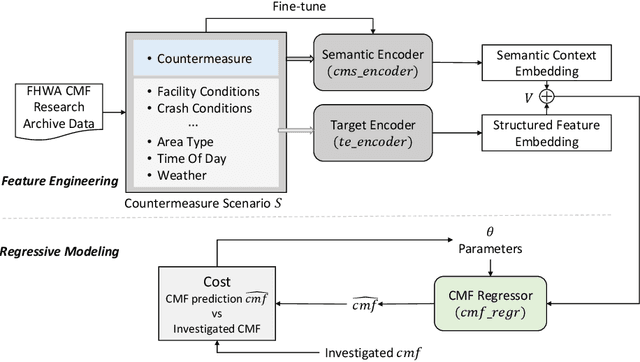

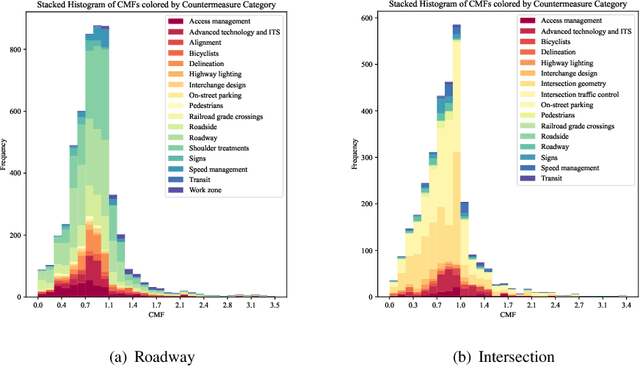
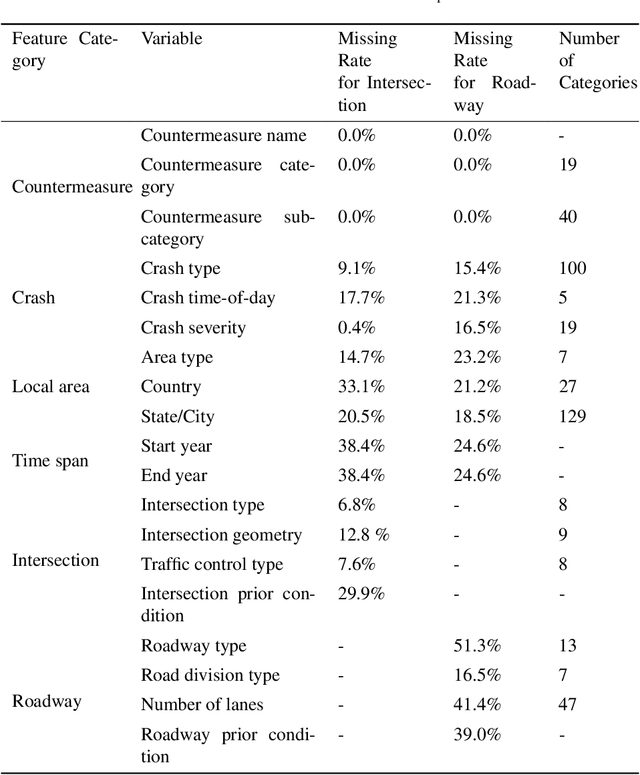
Abstract:Precise estimation of Crash Modification Factors (CMFs) is central to evaluating the effectiveness of various road safety treatments and prioritizing infrastructure investment accordingly. While customized study for each countermeasure scenario is desired, the conventional CMF estimation approaches rely heavily on the availability of crash data at given sites. This not only makes the estimation costly, but the results are also less transferable, since the intrinsic similarities between different safety countermeasure scenarios are not fully explored. Aiming to fill this gap, this study introduces a novel knowledge-mining framework for CMF prediction. This framework delves into the connections of existing countermeasures and reduces the reliance of CMF estimation on crash data availability and manual data collection. Specifically, it draws inspiration from human comprehension processes and introduces advanced Natural Language Processing (NLP) techniques to extract intricate variations and patterns from existing CMF knowledge. It effectively encodes unstructured countermeasure scenarios into machine-readable representations and models the complex relationships between scenarios and CMF values. This new data-driven framework provides a cost-effective and adaptable solution that complements the case-specific approaches for CMF estimation, which is particularly beneficial when availability of crash data or time imposes constraints. Experimental validation using real-world CMF Clearinghouse data demonstrates the effectiveness of this new approach, which shows significant accuracy improvements compared to baseline methods. This approach provides insights into new possibilities of harnessing accumulated transportation knowledge in various applications.
Joint Optimization of Traffic Signal Control and Vehicle Routing in Signalized Road Networks using Multi-Agent Deep Reinforcement Learning
Oct 16, 2023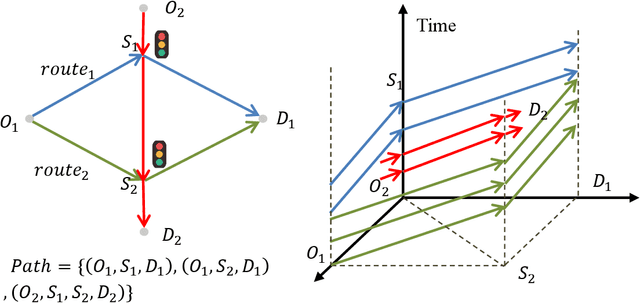
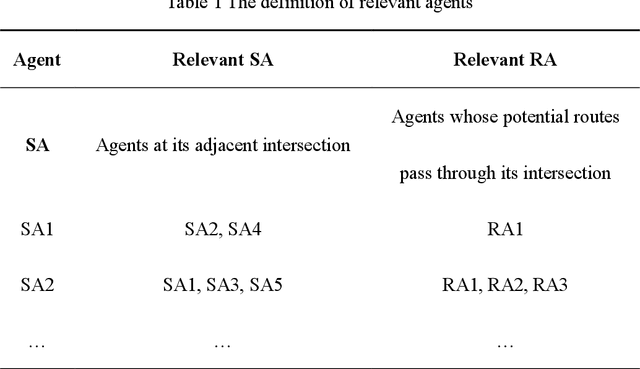
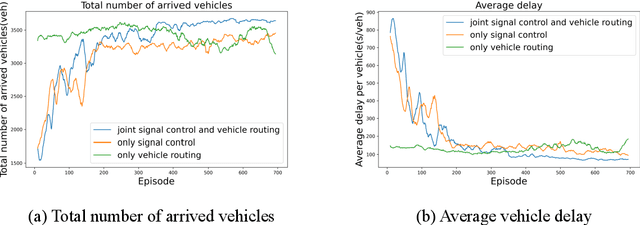
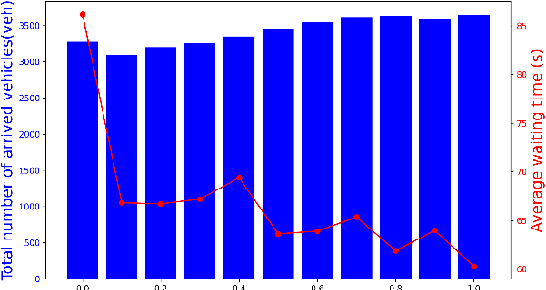
Abstract:Urban traffic congestion is a critical predicament that plagues modern road networks. To alleviate this issue and enhance traffic efficiency, traffic signal control and vehicle routing have proven to be effective measures. In this paper, we propose a joint optimization approach for traffic signal control and vehicle routing in signalized road networks. The objective is to enhance network performance by simultaneously controlling signal timings and route choices using Multi-Agent Deep Reinforcement Learning (MADRL). Signal control agents (SAs) are employed to establish signal timings at intersections, whereas vehicle routing agents (RAs) are responsible for selecting vehicle routes. By establishing relevance between agents and enabling them to share observations and rewards, interaction and cooperation among agents are fostered, which enhances individual training. The Multi-Agent Advantage Actor-Critic algorithm is used to handle multi-agent environments, and Deep Neural Network (DNN) structures are designed to facilitate the algorithm's convergence. Notably, our work is the first to utilize MADRL in determining the optimal joint policy for signal control and vehicle routing. Numerical experiments conducted on the modified Sioux network demonstrate that our integration of signal control and vehicle routing outperforms controlling signal timings or vehicles' routes alone in enhancing traffic efficiency.
EVKG: An Interlinked and Interoperable Electric Vehicle Knowledge Graph for Smart Transportation System
Apr 10, 2023Abstract:Over the past decade, the electric vehicle industry has experienced unprecedented growth and diversification, resulting in a complex ecosystem. To effectively manage this multifaceted field, we present an EV-centric knowledge graph (EVKG) as a comprehensive, cross-domain, extensible, and open geospatial knowledge management system. The EVKG encapsulates essential EV-related knowledge, including EV adoption, electric vehicle supply equipment, and electricity transmission network, to support decision-making related to EV technology development, infrastructure planning, and policy-making by providing timely and accurate information and analysis. To enrich and contextualize the EVKG, we integrate the developed EV-relevant ontology modules from existing well-known knowledge graphs and ontologies. This integration enables interoperability with other knowledge graphs in the Linked Data Open Cloud, enhancing the EVKG's value as a knowledge hub for EV decision-making. Using six competency questions, we demonstrate how the EVKG can be used to answer various types of EV-related questions, providing critical insights into the EV ecosystem. Our EVKG provides an efficient and effective approach for managing the complex and diverse EV industry. By consolidating critical EV-related knowledge into a single, easily accessible resource, the EVKG supports decision-makers in making informed choices about EV technology development, infrastructure planning, and policy-making. As a flexible and extensible platform, the EVKG is capable of accommodating a wide range of data sources, enabling it to evolve alongside the rapidly changing EV landscape.
 Add to Chrome
Add to Chrome Add to Firefox
Add to Firefox Add to Edge
Add to Edge